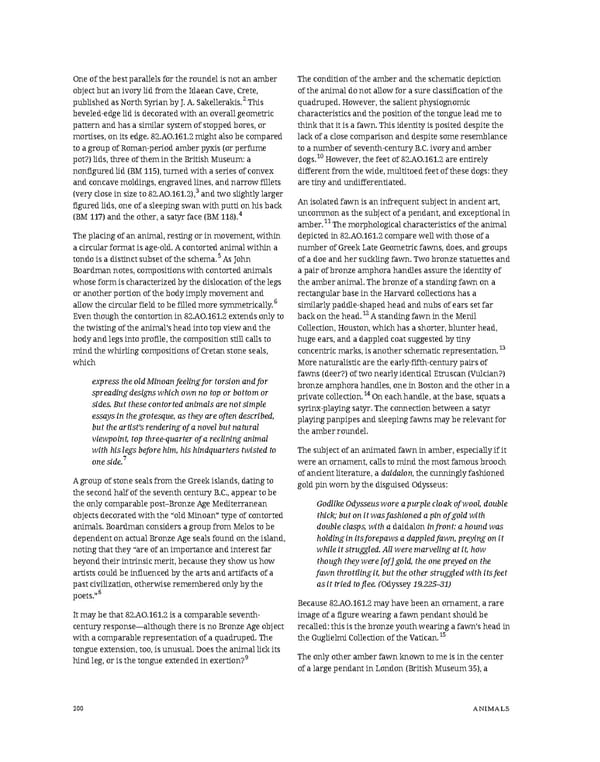One of the best parallels for the roundel is not an amber The condition of the amber and the schematic depiction object but an ivory lid from the Idaean Cave, Crete, of the animal do not allow for a sure classification of the published as North Syrian by J. A. Sakellerakis.2 This quadruped. However, the salient physiognomic beveled-edge lid is decorated with an overall geometric characteristics and the position of the tongue lead me to pattern and has a similar system of stopped bores, or think that it is a fawn. This identity is posited despite the mortises, on its edge. 82.AO.161.2 might also be compared lack of a close comparison and despite some resemblance to a group of Roman-period amber pyxis (or perfume to a number of seventh-century B.C. ivory and amber pot?) lids, three of them in the British Museum: a dogs.10 However, the feet of 82.AO.161.2 are entirely nonfigured lid (BM 115), turned with a series of convex different from the wide, multitoed feet of these dogs: they and concave moldings, engraved lines, and narrow fillets are tiny and undifferentiated. (very close in size to 82.AO.161.2),3 and two slightly larger figured lids, one of a sleeping swan with putti on his back An isolated fawn is an infrequent subject in ancient art, (BM 117) and the other, a satyr face (BM 118).4 uncommon as the subject of a pendant, and exceptional in amber.11The morphological characteristics of the animal The placing of an animal, resting or in movement, within depicted in 82.AO.161.2 compare well with those of a a circular format is age-old. A contorted animal within a number of Greek Late Geometric fawns, does, and groups tondo is a distinct subset of the schema.5 As John of a doe and her suckling fawn. Two bronze statuettes and Boardman notes, compositions with contorted animals a pair of bronze amphora handles assure the identity of whose form is characterized by the dislocation of the legs the amber animal. The bronze of a standing fawn on a or another portion of the body imply movement and rectangular base in the Harvard collections has a allow the circular field to be filled more symmetrically.6 similarly paddle-shaped head and nubs of ears set far Even though the contortion in 82.AO.161.2 extends only to back on the head.12 A standing fawn in the Menil the twisting of the animal’s head into top view and the Collection, Houston, which has a shorter, blunter head, body and legs into profile, the composition still calls to huge ears, and a dappled coat suggested by tiny mind the whirling compositions of Cretan stone seals, concentric marks, is another schematic representation.13 which More naturalistic are the early-fifth-century pairs of fawns (deer?) of two nearly identical Etruscan (Vulcian?) express the old Minoan feeling for torsion and for bronze amphora handles, one in Boston and the other in a spreading designs which own no top or bottom or private collection.14 On each handle, at the base, squats a sides. But these contorted animals are not simple syrinx-playing satyr. The connection between a satyr essays in the grotesque, as they are often described, playing panpipes and sleeping fawns may be relevant for but the artist’s rendering of a novel but natural the amber roundel. viewpoint, top three-quarter of a reclining animal with his legs before him, his hindquarters twisted to The subject of an animated fawn in amber, especially if it one side.7 were an ornament, calls to mind the most famous brooch of ancient literature, a daidalon, the cunningly fashioned A group of stone seals from the Greek islands, dating to gold pin worn by the disguised Odysseus: the second half of the seventh century B.C., appear to be the only comparable post–Bronze Age Mediterranean Godlike Odysseus wore a purple cloak of wool, double objects decorated with the “old Minoan” type of contorted thick; but on it was fashioned a pin of gold with animals. Boardman considers a group from Melos to be double clasps, with a daidalon in front: a hound was dependent on actual Bronze Age seals found on the island, holding in its forepaws a dappled fawn, preying on it noting that they “are of an importance and interest far while it struggled. All were marveling at it, how beyond their intrinsic merit, because they show us how though they were [of] gold, the one preyed on the artists could be influenced by the arts and artifacts of a fawn throttling it, but the other struggled with its feet past civilization, otherwise remembered only by the as it tried to flee. (Odyssey 19.225–31) poets.”8 Because 82.AO.161.2 may have been an ornament, a rare It may be that 82.AO.161.2 is a comparable seventh- image of a figure wearing a fawn pendant should be century response—although there is no Bronze Age object recalled: this is the bronze youth wearing a fawn’s head in with a comparable representation of a quadruped. The the Guglielmi Collection of the Vatican.15 tongue extension, too, is unusual. Does the animal lick its hind leg, or is the tongue extended in exertion?9 The only other amber fawn known to me is in the center of a large pendant in London (British Museum 35), a 200 ANIMALS
 Ancient Carved Ambers in the J. Paul Getty Museum Page 209 Page 211
Ancient Carved Ambers in the J. Paul Getty Museum Page 209 Page 211